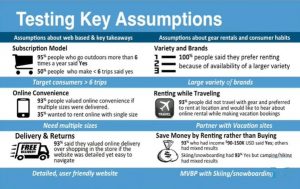To design and build your product, you need to know how to identify key assumptions and test to validate or invalidate them. By this point, you have made a lot of assumptions in developing our business. Remember, by this time, in real life with the business that you’re working on, you should know if it’s viable, profitable, sustainable, and even scalable; before you get to this point, you are almost ready to build something and spend some money.
Identify Critical Assumptions
Here are some of the assumptions that you want to validate;
1| Gross margins
Are your gross margins accurate? Is there a way to test that because our financials are based on that?
2| Personas top priorities
You have made a bunch of assumptions on what your persona’s top priorities and pain points are?
3|Is your value proposition attractive to our end users?
4| Is their interest by lighthouse users and linchpin customers?
5| Your customer decision-making unit and decision-making process.
6| key resources and partners and relationships, we need to deliver our product.
There are a number of things that you want to check on before you actually spend the money to build.
Test Critical Assumptions
How do we test these critical assumptions?
1| Gross Margin (Cost of production)
-Send a Request For Quotation (RFQ)
Well, if you’re trying to test your gross margin, send out a request for a quote. You can do requests for quotes pretty quickly. Go to those that do manufacturing and production if you’re going to do a product, and actually do a request for quotes to see what the real prices are.
2| Persona’s top priorities
If you’re looking at your persona, your end-users top priorities, their pain points, go to them, approach them with where you’re at. Now, remember, you’ve gone through these different stages of doing interviews all the way back and primary market research, but you didn’t tell them what your solution was. When you did your high-level product specification, and you went back to them and shared it with them, you’ve come a long way since then.
Now you have all your details worked out, go back to your persona and to your other end users in that pool, and ask them, show them what you have now, see if they’re interested.
3| Value proposition – share desire to purchase
Show them your value proposition. Do they have a desire at that point to purchase? Are they moved by the value proposition? Do they relate to your problem statement? Are they interested in your ideal solution?
4| Lighthouse, Linchpin customer intent to pay
With your lighthouse and lynchpin customers, can you move them along the road towards buying or prepaying? From all the way from a pilot where they’ll let you bring it in, show it to them, or they’ll run a pilot, a letter of intent to purchase, a deposit to purchase or even prepay. These are all different stages of showing the level of intent of your lighthouse users and your linchpin customers to actually purchase your product.
5| Decision-making unit/Decision-making process
Another thing in testing critical assumptions is your decision-making unit. Your decision-making process is actually walked through the actual purchase with your end-user customer. They may not end up purchasing it, but at least now you have all the details to accurately walk through that process because now you’re almost ready to build. A lot of these things can help you.
6| Key resources and partners
With the key resources and partners, will they show the letter of intent to commit? What level of commitment will they show you towards purchasing or becoming involved with you or helping you to build your product if they’re key partners and relationships? You want to test as many assumptions as you can.
Which Assumptions to Test First
When it comes to these assumptions, which ones do you test first?
-
Riskiest
-
Longest lead time
Well, the ones that are the riskiest are the ones that have the longest lead time. If you’re going to do production, for example, and you’ve got a long lead time on production that could severely impact everything else in the organization. Remember, time is money. The longer the lead time, the longer the runway for cash flow and survivability, at times the decision-making process of your customer may take 6 to 12 months to close a deal. That is very important information to understand.
-
Costliest if invalidated
And lastly, what’s the costliest issue in your assumption if it is invalidated? What is going to cost the most?
These are big areas to test; riskiest, longest lead time and costly as if it’s invalidated. How to identify key assumptions involves picking your first one, pick the high-thought hypothesis you want to test, and then conduct an activity to validate or invalidate that assumption.
Find below an example of Bentrix a company that wanted to venture into either skiing/snowboarding and camping/hiking and tested assumptions about skiing and camping gear rentals and online service delivery to enable them to validate or invalidate their assumptions.

The two lessons were that the website better be detailed and user friendly and the minimum viable business product they should start with was skiing and snowboarding and then add on camping and hiking later. Some great assumptions that they learned that would significantly impact the launch, the minimum viable business product, and actually their budget, capital expenditures. Now they needed more sizes and a greater variety and focusing on people that traveled six times or more. These were some great assumptions to test and validate right before they built their product.
Conclusion
When you want to understand how to identify key assumptions, you need to look at the desirability, viability, feasibility, and adaptability of the assumptions. What you think is the top need for the customer may be invalidated by the customer feedback. This feedback is key in helping you to design and build your minimum viable product.

